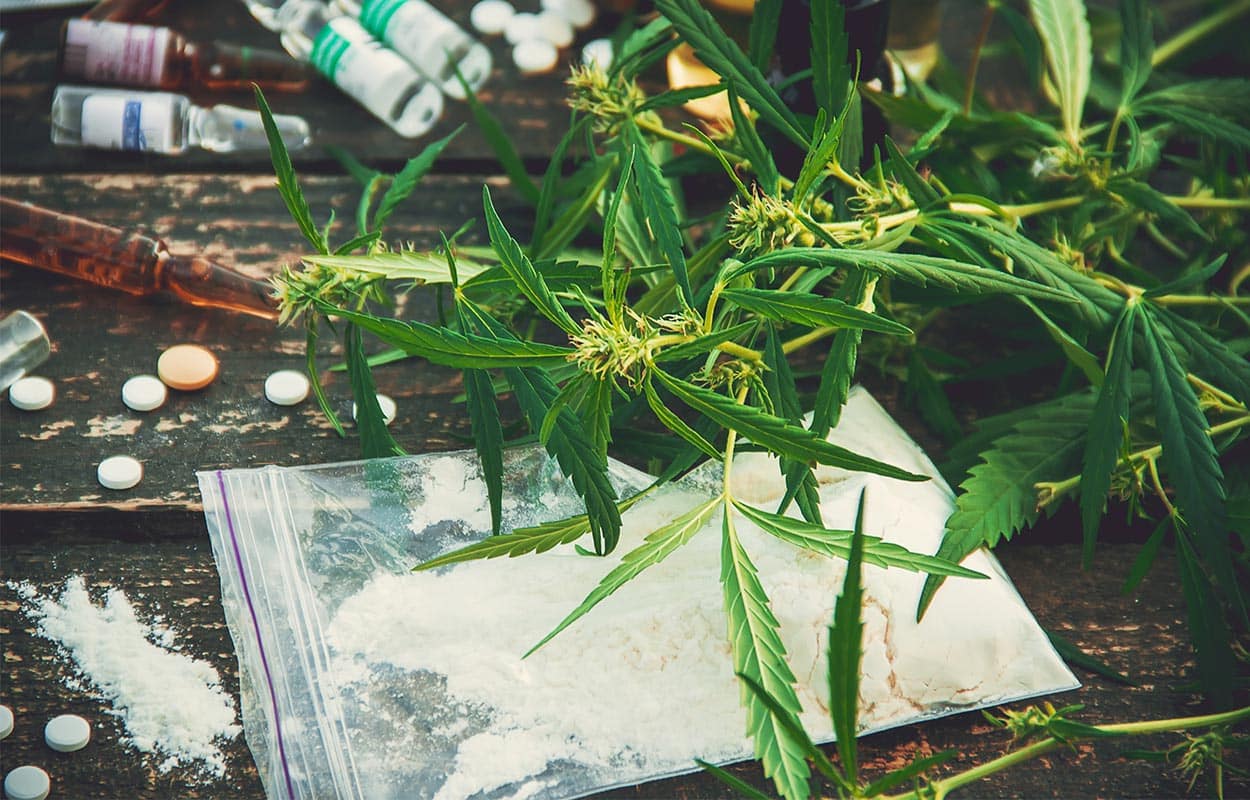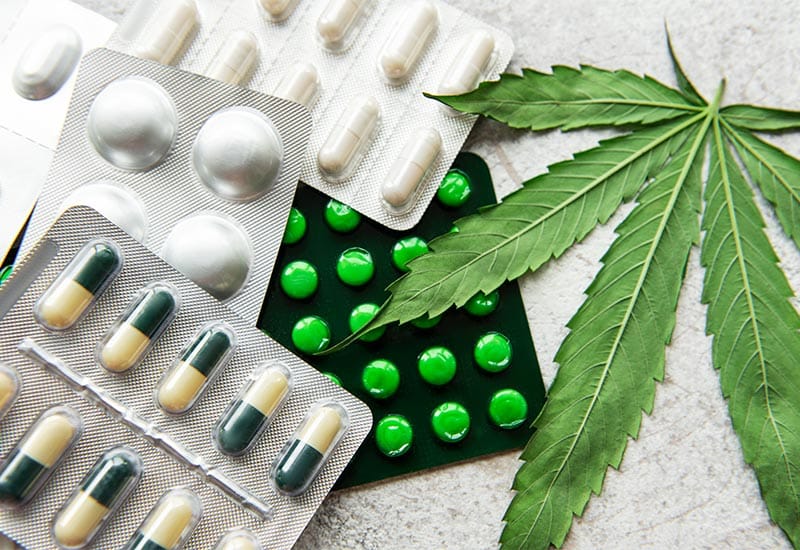Gateway Drugs: What are They & Why You Should be Concerned
Medically Reviewed By:
Written By:
Updated On: August 18, 2025
Last Medically Reviewed on: August 18, 2025

Table of Contents
Key Points
- Gateway drugs are considered milder drugs that can lead to the use of more powerful drugs and addiction.
- Tobacco, marijuana, and alcohol are all considered popular gateway drugs.
- Using gateway drugs is risky because it can also lead to legal problems and mental health issues.
- Besides using gateway drugs, other risk factors for addiction include environmental issues, genetics, and trouble at school.
The theory behind gateway drugs has existed for years and has been scientifically proven to have some merit. Researchers studying this idea followed adolescents who started using some of these popular gateway drugs to see if it did indeed lead to riskier drug abuse in the future
Studies show that when adolescents adopted gateway drugs, there was a significant increase in illegal drugs and cocaine use as they got older. [1] Findings like these emphasize the risks that gateway drugs carry and why there are concerns when people start taking them.
What are Gateway Drugs?
Gateway drugs are considered milder drugs that can influence the use of more addictive drugs or illicit substances. Many gateway drugs are legal and easily attainable, making usage prevalent. People, especially teenagers, often think that using them poses no risks. In reality, gateway drugs carry many potential dangers.
Why are They Considered Risky?
While gateway drugs are habit-forming in their own right, the gateway theory of substance use is the idea that using one substance leads people to put themselves at a greater risk for using other substances and substance abuse. [2]
There are concerns that gateway drugs can lead to health problems, addiction, legal problems, and mental health issues. When people use drugs, their judgment can become impaired, leading them to do things they wouldn’t normally do. This can result in fines or even arrest.
Using gateway drugs can also impair relationships if people begin to isolate themselves to use drugs. Depression and anxiety are also mental health concerns, as substance use can lead to both of these conditions. [3]
Gateway drug use can also impact brain development among young people. For some, gateway drug use can have a financial impact if people are using all of their money to purchase these substances.
Examples of Gateway Drugs
There are several common gateway drugs that many people may experiment with. Some people try one or more of the following: [4]
Alcohol
Alcohol is considered the most commonly used gateway drug. It appeals to many people because of the way it impacts the brain’s reward center. Alcohol suppresses the nervous system, impairs brain function, and makes it difficult to think rationally. [5] When people are under the influence of alcohol, their inhibitions are lowered. This alcohol use can lead them to try other drugs or engage in risky behavior.
The more a person drinks, the greater the effects alcohol will have on their body.
These can include: [6]
- Vomiting
- Low blood pressure
- Headache
- Difficulty breathing
- Loss of motor coordination
- Memory impairment
- Impaired judgement
- Sedation
- Relaxation
- Liver damage
In severe cases, alcohol poisoning can result in coma and even death.
Marijuana
Marijuana is considered one of the most common gateway drugs. It is derived from the Cannabis sativa plant that contains tetrahydrocannabinol (THC). This is the main chemical that makes people feel high.
As of August 2025, it is legal for adults to use marijuana for recreational purposes in 24 states, three territories, and the District of Columbia. [7] It is legal for medical use in 40 states, three territories, and the District of Columbia.
Despite its legality in many states, using marijuana still carries risk. Over time, the body becomes accustomed to the substance, meaning one has to take more of it to get the same effects or turn to stronger substances.
When people smoke marijuana, THC passes from the lungs into the bloodstream. From there, the blood brings it to the brain and other organs. When people use marijuana, it can impact brain function in many ways, such as: [8]
- Feelings of euphoria
- Altered senses
- Issues with problem-solving
- Memory problems
- Dizziness
- Sleepiness
- Disorientation
- Confusion
- Slower reaction time
It can also lead to nausea, dry mouth, and increased appetite, which may be why many people who smoke marijuana are said to get the “munchies” after using the drug.
Tobacco
The dangers of tobacco products as gateway drugs should not be overlooked. According to the Centers for Disease Control and Prevention, tobacco use is the leading cause of preventable death in the U.S. [9] Smoking can lead to cancer, lung disease, heart disease, and other serious illnesses.
Tobacco contains nicotine, which stimulates the central nervous system. [9] After a person uses nicotine, they may feel more relaxed and have an increased ability to focus. People also get short-term enjoyment from the nicotine found in tobacco, leading to its addictive potential.
Besides cigarettes, vaping is also considered a gateway drug. Researchers at Columbia University Mailman School of Public Health found that young people who vape have a higher risk of binge drinking and cannabis use. [10] When people vape, they inhale a mist of nicotine and flavoring. Vaping is also prevalent among adults, with 6.5% saying they vaped in 2023. Young adults ages 21-24 were the most likely to vape. [11]
Prescription Drugs
Prescription medication also falls under the umbrella of gateway drugs. Opioids, tranquilizers, and stimulants prescribed for medical use can lead to misuse. Many people who are not prescribed these types of medications can also get access to them, leading to habit-forming behaviors. These medicines can cause a high, leading people to want more of them or look for more potent, often cheaper drugs.
Caffeine
Some people also classify caffeine as a gateway drug. Caffeine is a stimulant that blocks adenosine, a neurotransmitter that promotes sleep, resulting in increased alertness and reduced fatigue. It is found in various foods and drinks, including coffee and energy drinks.
Caffeine has many effects on your body’s metabolism. It stimulates your central nervous system, which can make you feel more awake and give you a boost of energy. Caffeine is a diuretic, meaning it helps your body eliminate excess salt and water by increasing urination. The substance also increases the release of acid in your stomach, which can sometimes lead to an upset stomach or heartburn. Additionally, it may interfere with the absorption of calcium in the body and increase your blood pressure.
Having too much caffeine can lead to: [12]
- Anxiety
- Sleeping problems
- Irritability
- Seizures
- Irregular heartbeat
Mixing caffeine with other drugs, such as alcohol, can also have damaging effects on the body by masking the sedative effects alcohol can produce.
What are Other Risk Factors for Illegal Drug Use Besides Gateway Drugs?
Many factors put people at risk for using illegal drugs, besides first using gateway drugs.
These are some of the things to look for: [13]
- Genetics can play a role because people react to drugs differently. Some people may try a drug and like the effects, while others want nothing more to do with it.
- Environmental issues, such as a problematic home life
- Spending time around other people who use drugs
- Trouble at school or making friends
- Mental health problems such as depression and anxiety
If you know you fall into one of these risk categories, staying away from gateway drugs can be beneficial so you don’t add another potential risk factor for substance misuse.
Addiction Treatment for Gateway Drugs is Available
If you or a loved one has formed an addiction to any of the gateway drugs listed above or others, or is worried that it can lead to other substance use, treatment programs are available. Seeking treatment as early as possible is key to a more successful recovery..
Frequently Asked Questions About Gateway Drugs
How can I tell if someone is becoming addicted to a gateway drug?
Signs of addiction to gateway drugs are similar to those of other substances. They include behavioral changes, changes in physical appearance, lack of motivation, trouble with relationships, and irresponsibility, such as missing work or school, as well as changes in sleep patterns.
Do all gateway drugs lead to riskier drugs later in life?
Everyone is different, so gateway drugs do not necessarily lead to illegal drug use later in life. But they are known to increase the risk of this activity.
How difficult is it to quit gateway drugs?
This answer will differ from person to person. The type of drug and level of dependence are key factors. People can form a strong physical and mental dependence on alcohol, tobacco, and marijuana. If someone is using these substances as an escape from their personal problems, quitting can become difficult. Seeking treatment options is the best way to quit using a gateway drug.
If I become addicted to a gateway drug, what types of treatment are available?
If you develop an addiction to a gateway drug, treatment can range from a detox and rehab to different types of therapy, including individual and/or group therapy, inpatient and outpatient treatment, cognitive and behavioral therapies, 12-step groups, family and friend support, and medications. Healthcare professionals will assess your addiction and determine the best course of treatment.
What are examples of addictive drugs?
Examples of addictive drugs would be opioids or narcotics like painkillers, heroin, morphine, and fentanyl, benzodiazepines like Xanax and Valium, and stimulants like Adderall and cocaine. Addictive substances aren’t just illicit substances, but also include easily accessible substances like alcohol, nicotine, and, in many states, marijuana.
There is a Better Way to Live. It's Time to Get the Help You Deserve.
Take the first step in getting your life back. Speak with our admissions team today.Sources
[1] Nkansah-Amankra, S., & Minelli, M. (2016, May 28). “Gateway hypothesis” and early drug use: Additional findings from tracking a population-based sample of adolescents to adulthood. Preventive medicine reports. Retrieved from https://pmc.ncbi.nlm.nih.gov/articles/PMC4929049/ On August 11, 2025.
[2] Author links open overlay panelMichael M Vanyukov a, a, b, c, d, e, AbstractVariation in the risk for and severity of substance use disorders (SUD) in the population is caused by multiple organismic (genetic, Vanyukov, M. M., Darke, S., Bree, M. B. van den, Cadoret, R. J., Grove, W. M., Swan, G. E., Levy, F., Sherman, D. K., Biederman, J., Clark, D. B., Koob, G. F., Schultz, W., … Bierut, L. (2003, September 22). Liability to substance use disorders: 1. common mechanisms and manifestations. Neuroscience & Biobehavioral Reviews. Retrieved from https://www.sciencedirect.com/science/article/abs/pii/S0149763403000897?via%3Dihub on August 11, 2025.
[3] U.S. Department of Health and Human Services. (2025, January 8). Addiction and health. National Institutes of Health. Retrieved from https://nida.nih.gov/publications/drugs-brains-behavior-science-addiction/addiction-healthon August 11, 2025.
[4] [5] [6] [10] Bazan, C., Barnes, B., Santens, R., & Verone, E. (n.d.). Gateway Drugs (caffeine, alcohol, tobacco, marijuana). Illinois Open Publishing Network. Retrieved from https://iopn.library.illinois.edu/pressbooks/druguseandmisuse/chapter/gateway-drugs-caffeine-alcohol-tobacco-marijuana/ on August 11, 2025.
[7] State Medical Cannabis Laws. (n.d.-j). Retrieved from https://www.ncsl.org/health/state-medical-cannabis-laws on August 11, 2025.
[8] professional, C. C. medical. (2025a, March 19). Marijuana. Cleveland Clinic. Retrieved from https://my.clevelandclinic.org/health/articles/4392-marijuana-cannabis on August 11, 2025.
[9] Centers for Disease Control and Prevention. (2024a, October 8). Burden of cigarette use in the U.S. Centers for Disease Control and Prevention. Retrieved from https://www.cdc.gov/tobacco/campaign/tips/resources/data/cigarette-smoking-in-united-states.html on August 11, 2025.
[10] Is vaping new gateway into further substance use?. Columbia University Mailman School of Public Health. (2024, July 31). Retrieved from https://www.publichealth.columbia.edu/news/vaping-new-gateway-further-substance-use on August 11, 2025.
[11] Centers for Disease Control and Prevention. (2023, July 21). Products – data briefs – number 475 – July 2023. Centers for Disease Control and Prevention. Retrieved from https://www.cdc.gov/nchs/products/databriefs/db475.htm#:~:text=Interview%20Survey%2C%202021.-,Summary,cigarettes%20and%20cigarettes%20(0.8%25) on August 11, 2025.
[12] Caffeine. Alcohol and Drug Foundation. (2025, May 18). Retrived from https://adf.org.au/drug-facts/caffeine/ on August 11, 2025.
[13] U.S. National Library of Medicine. (n.d.-c). Drug use and addiction. MedlinePlus. Retrieved from https://medlineplus.gov/druguseandaddiction.html on August 11, 2025.



